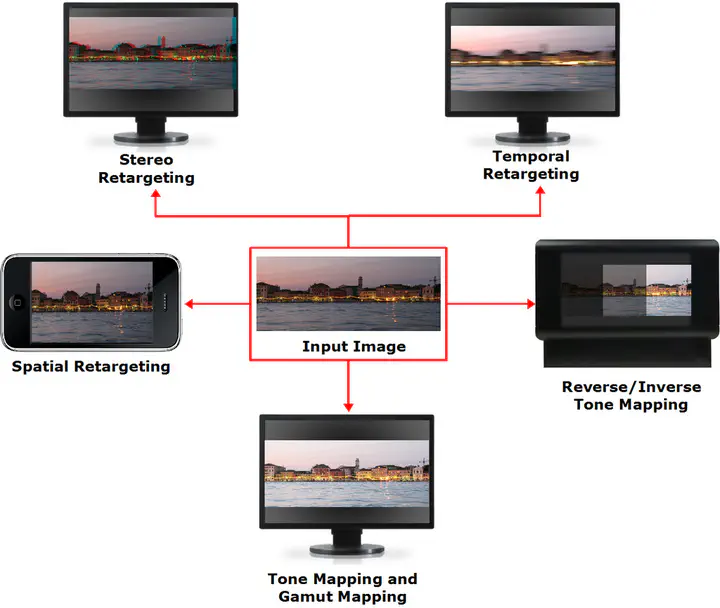
Abstract
abstract
Retargeting is a process through which an image/a video is adapted from the display device for which it was meant (target display) to another one (retarget display). The retarget display has different features from the target one such as: dynamic range, discretization levels, color gamut, multi-view (3D), refresh rate, spatial resolution… This is a very relevant and hot topic in graphics, given the increasing number of display devices, from large, high-contrast screens to small cell phones with limited dynamic range; a lot of techniques are being published in different venues, and it’s simply very hard to keep up. For instance, one of the few cases for which retargeting can be potentially straightforward is when adapting images from a larger display (in term of resolution) to a smaller one with the same aspect ratio: a low-pass filter followed by downsampling can then achieve good quality results. However, for most cases retargeting can be an ill-posed problem, such as when displaying Low Dynamic Range (LDR) or 8-bit content on High Dynamic Range (HDR) displays. Such a problem requires the retargeting algorithm to generate new content which is missing in the input image/frame. In this course, we will present the latest solutions and techniques for retargeting images along various dimensions such as dynamic range, colors, temporal and spatial resolutions, and offer for the first time a much-needed holistic view of the field. Moreover, we are going to show how to measure and analyze the changes applied to an image/video in terms of quality using both (subjective) psychophysical experiments and (objective) computational metrics. The course should be of interest to anyone involved in graphics in its broader sense, given the almost unavoidable need to retarget results to different devices: from developer that are interested to implement retargeting techniques, to users that just need an overall perspective, for researchers fully engaged in developing multi-dimensional retargeting techniques, for whom this course will serve as a solid background for future algorithms.
Syllabus: Introduction by Francesco Banterle Dynamic Range Retargeting: Tone Mapping by Rafal Mantiuk Dynamic Range Retargeting: Cornsweet Illusion and Glare in Tone Mapping by Karol Myszkowski Dynamic Range Retargeting: The Color Issue by Alessandro Artusi Dynamic Range Retargeting: Reverse/Inverse Tone Mapping by Francesco Banterle Spatial Image Retargeting by Diego Gutierrez Temporal Image Retargeting by Elmar Eisemann and Karol Myszkowski Quality Metrics by Tunc Aydin Stereo Retargeting by Piotr Didyk